
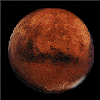 Mars
Mars

Planet Profile
Mass ................................................ 6.42 X 1023 kg Diameter .................................................. 6,787 km Mean density ............................................... 3.94 gm/cm3 Escape velocity ........................................... 5,000 m/s Average distance from Sun (AU)............................. 1.524 Rotation period (length of day in Earth days).............. 1.026 Revolution period (length of year in Earth days).......... 686.98 Obliquity (tilt of axis)...................................... 25° Orbit inclination .......................................... 1.85° Orbit eccentricity (deviation from circular)............... 0.093 Maximum surface temperature ................................. 310 °K Minimum surface temperature ................................. 150 °K Visual geometric albedo (reflectivity)...................... 0.15 Highest point on surface.............................Olympus Mons (24 km above surrounding plains) Atmospheric components........................ 95% carbon dioxide 3% nitrogen 1.6% argon Surface materials............ basaltic rock and altered materials

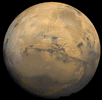 Canyon and Volcanoes (Enlarge view)
Canyon and Volcanoes (Enlarge view)This mosaic of Mars is similar to the view you would see from a spacecraft. The center of the scene shows the entire Valles Marineris canyon system, over 4000 km (2486 mi) long and up to 7 km (5 mi) deep. It extends from Noctis Labyrinthus on the west side to the chaotic terrain on the east side. Many ancient river channels begin from the chaotic terrain and north-central canyons and run north. Three Tharsis volcanoes are visible to the west (dark red spots). They rise 10 to 18 km (6 to 11 mi) above the Tharsis Plateau, attaining elevations of 18 to 26 km (11 to 16 mi).
 Schiaparelli (Enlarge view)
Schiaparelli (Enlarge view)This mosaic of Mars is composed of about 100 Viking Orbiter images. The images were acquired in 1980 during mid-northern summer on Mars. Crater Schiaparelli, left of center, is 461 km (277 mi) in diameter. The dark streaks with bright margins emanating from craters in the Oxia Palus region, in the upper left, are caused by erosion and deposition by the wind. Bright white areas to the south, including the Hellas impact basin at extreme lower right, are covered by carbon dioxide frost.
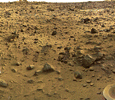 View From Viking Lander 1 (Enlarge view)
View From Viking Lander 1 (Enlarge view)This image was taken at the Viking Lander 1 site, using camera 2. The lander's footpad is visible in the lower right. This scene shows a rocky field with trenches in the foreground (just below center) dug by the sampler arm. Patches of drift material and possibly bedrock are visible further from the lander.
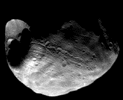 Phobos
PhobosPhobos is the innermost satellite of Mars. It is so close to the planet that it revolves around Mars faster than Mars rotates, and as seen from the surface of Mars it actually rises in the west and sets in the east. (Coincidentally, Mars has a rotation, tilt, and day almost exactly like that of the Earth, so normally things move east-to-west in 12 hours across the Martian sky, as they do on Earth.) One of the most striking features on the tiny (16-mile diameter) irregularly shaped Phobos is the presence of grooves over most of its surface. The grooves seem to radiate in all directions from the giant Stickney crater and converge on the opposite side of the satellite.
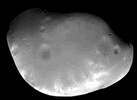 Deimos
DeimosDeimos is the outer-most moon of Mars. Its distance from Mars is such that it very nearly rotates around Mars in one day. So, as seen from Mars, Deimos moves very slowly across the sky, taking about two and an half days between rising and setting. (If Deimos rotated around Mars in exactly one day, then it would not appear to move at all, just as geosynchronous communications satellites do not.) This computer mosaic of Deimos was made with images acquired from the Viking Orbiter during one of its close approaches to the moon. Scientists speculate that both Deimos and Phobos were once passing asteroids that were pulled in by Mars' gravity.
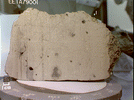 Martian Meteorite (Enlarge view)
Martian Meteorite (Enlarge view)This meteorite was collected in Elephant Moraine, Antarctica in 1979, but scientists believe that it came from the planet Mars. (The idea is that a dinosaur-killer-size comet hit Mars, blasted some of the rocks into outer space, and then they floated around the solar system for a few million years before finally falling on Earth.) This meteorite also contains vesicles, or shiny pockets, which contain air very much like the air measured on Mars by the Viking spacecraft. This meteorite is 180 million years old. A meteorite similar to this one has recently, with great fanfare and controversy, been claimed to show evidence of microscopic life -- in other words, to show proof of ancient life on Mars.
